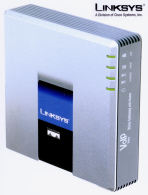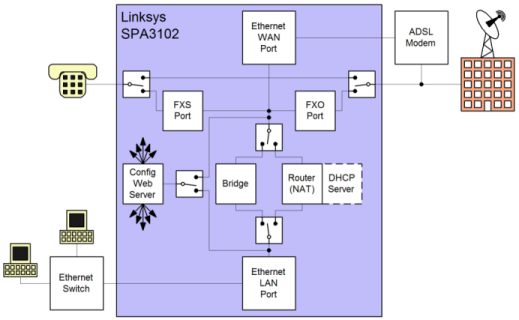 |
 |
 |
 |
 |
 |
 |
|
Linksys SPA3102 - Voice Gateway with Router
On the face of it, this device should be superb. In practice, it is all that one might expect from the spec sheet, but if you're a novice, like I was with IP telephony and such, expect a fairly steep learning curve. Hopefully these pages will act as a guide to avoiding some of the pitfalls. The SPA3102 is a hardware VoIP phone, which uses the SIP call routing specification. VoIP is fairly easy to understand. It allows a caller to use the internet as a medium to communicate a telephone call with another similarly equipped individual. If the handset is a paper cup, and the internet the string, then the SPA3102 is the knot on the end of the string. VoIP stands for Voice Over Internet Protocol. When you speak the sound is digitised, and sent directly alongside information like e-mail and web page data. Whilst it's a fine concept to talk for free using the internet between, say, the UK and Australia, there is still the small problem of call routing, and this is where SIP (Session Initiation Protocol) comes in. Using the SIP system messages are sent across the internet, in very similar way to those of a webpage or email. These messages allow a specific computer to be identified as a target for the VoIP communications traffic. The detailed mechanism will remain opaque. Suffice to say that it broadly makes use of the the same DNS system that is used to identify a computer as the source of a web page when a normal URL is typed into a browser window, or when an e-mail is sent. The object of SIP is to identify a target for voice traffic, and typically this will be an unnamed computer or a unit like the SPA3102. Unlike e-mail where the actual data sits on a mail server until the recipient collects it, the primary objective of a SIP server is to identify the client computer which will receive the voice traffic. Because the client computer will not necassarily be available the SIP server will identify the specific client and check that it is available before connecting the call. By this means one can talk across the internet to anyone with suitable equipment, using an address in the form "1234567@blahblah.com". Quite like an e-mail address. The diagram below illustrates the point;  The numbers indicate call routing progress, where 9 is the actual voice data being transferred between endpoints. In the detail there may be variation from reality, but the outline is there to see. The important step, is that which occurs between stage 4 and 5 in the remote SIP provider. This is where the final endpoint for the call is resolved, and is the essence of what SIP actually does. Whilst VoIP calls are free, the most useful feature of SIP is that one can get a remote but completely standard phone number that hooks into your SIP provider account. Normally it would be your main provider who supplies this, but there is no limit to the number of inbound phone numbers you can hook into a single SIP account. You could happily have one in each country. Typically inbound phone numbers cost very little, but obviously you will also want to make outbound calls, and these must be paid for. Normally your SIP provider provides the one phone number on which you can dial out. The SPA3102 looks like it should be capable of multiplexing more than one outbound provider, but this has not been tested. Comparing SIP with Skype, Skype is easier by far to set up and work with. It can do everything that SIP can, and perhaps more. When it comes to dealing in real phone numbers separated by the internet, SIP wins hands down on cost. You can pretty nearly get all of the SIP hardware and 1000 minutes of talk time for the cost of two years SkypeIn. With Skype you'd still only be talking on a softphone and that only works when your computer is switched on. The Skype hardware is comparitively expensive, and the ongoing costs of skypein reveal the difference. There are lots of different SIP solutions on the market, some like that of BT, the "Home Hub" are locked to a single service provider. Others have been designed around a particular provider, and some are niether configured nor designed for any particular provider. The SPA3102 can be locked to a specific provider, but when bought on their own without an associated provider package, are usually not locked. Certainly, equipment like the "Home Hub" can be unlocked and then used with any provider. In general the SIP system does not easily traverse a firewall/router. With this in mind, it is better to opt for a hardware SIP unit which can easily be used on the internet side of any router. Unfortunately if you have a combined ADSL modem/router and value your router/firewall this is difficult to achieve, without recourse to buying a new router. In extremis, it is not possible to operate a unit like the SPA3102 inside a NAT (Network Address Translation) router if the router does not have a static IP address on the internet. Given the choice between a new router, and obtaining a Static IP address, the latter is likely to be cheaper, but perhaps less convenient. Many VoIP solutions now have built in ADSL modem/routers and this greatly simplifies setup of the VoIP hardware. The SPA3102 is actually a router, with firewall style capability, and it could be used on the outside of an existing router/switch. It does not however have an ADSL interface, so in many typical cases it must be used inside an existing router. It can do this, but it takes a bit more setting up. If you have separate ADSL modem and router/switch, then not only will the SPA3102 be easier to configure, it will be ideally suited to your system. The real attractiveness of the SPA3102 is that it has both an FXO and an FXS port. FXO and FXS are the interfaces with the PSTN/POTS or old analogue telepone system (brrring brrring). PSTN is Public Swtiched Telephone System, the fast modern core of telecommunications, and POTS the analogue bit (Post Office Telephone System - UK) that runs from the exchange to most people‘s homes. FXO and FXS are the names for the connections on the POTS system. FX is Foreign Exchange, and the "S" and "O" are Station and Office respectively. It might be easier to think of "S" as Subscriber, it sometimes makes more sense. The Office is the exchange, and the Subscriber the actual physical phone handset. Many VoIP solutions have one or more FXS ports and this is consistent with having more than one handset associated with a single internet phone unit. Certainly for an SME (small medium enterprise) such a solution is useful for multiple extensions, but perhaps for the home user, it is less so. Typically a second FXS port could be used for a fax machine, or an answerphone, but if you have a VoIP line, then both fax and Voicemail are easily implemented at the SIP provider. The FXO port then, is the one that offers the real power;
The diagram below reveals what the SPA3102 must contain;  The configuration interface can either be available on the WAN or the LAN port through a standard web browser. The analogue phone interfaces are only available on the WAN port. The configuration interface controls all aspects of the setup of the unit. A very small set of configuration options are available through the FXS port. This is achieved by dialling DTMF tones and listening to voice messages on a telephone handset. Linksys call this IVR (Interactive Voice Response). Most notable of these IVR configuration options is the factory reset. This is mainly useful when a combination of configuration options from the web interface conflict, and it is then the only way to regain access to the unit through the LAN port. Sadly the unit has no actual reset to defaults button. This is a blessing and a pain. There are so many configuration options, perhaps it is not desirable to reset it. The pain is that it does not ship with all of the necassary adapters to allow direct connection of an ordinary analogue phone (in the UK). If you make a mistake at the beginning, then you end up having to order the right connectors to get into the unit! The biggest single failing of the unit is that the loop for connecting FXO to FXS directly is only available as a failover. This means that if the unit loses power, then the old analogue phone connects directly through. This is a good feature since an analogue handset requires no power. It would still work on the old analogue line in a power failure. The problem is that when the power is on, and you attempt to make an analogue phone call, the call must be routed internally through the VoIP system. This mandatory VoIP routing of analogue calls introduces a delay into the loop between the handset and the exchange. The exchange would normally send back a good proportion of the signal from the microphone to the earpiece of an analogue phone. With the normally unnoticed VoIP delay this manifests as an unpleasant echo on the analogue line. The echo is only present on a phone connected to the analogue exchange by the the SPA3102 when the power is on. The other end of the call hears no echo. Depending on the exchange this will be more or less of a problem. Even if there is a significant problem with echo, there is scope to reduce it. It takes time, patience and experimentation to get rid of it. Even then it can be a compromise between sound level and echo intrusion. Overall, this then sets the tone for the whole setup procedure. The unit is very capable, and very flexible, but the manual is hopeless and you may find that you spend much time stabbing in the dark. Fortunately there are a few resources on the internet with useful advice, but in most cases you have to understand and interpret what you read to apply it to your situation. I hope that if you live in the UK (and possibly elsewhere - although it'll not be as appropriate), you'll be able to work through this guide fairly quickly. The aim is that when you get to the end, not only will your SPA3102 work, but when you look at the manual what you read will mean something. |
Copyright © Solid Fluid 2007-2025 |
Last modified: SolFlu Tue, 22 Sep 2009 03:03:00 GMT |